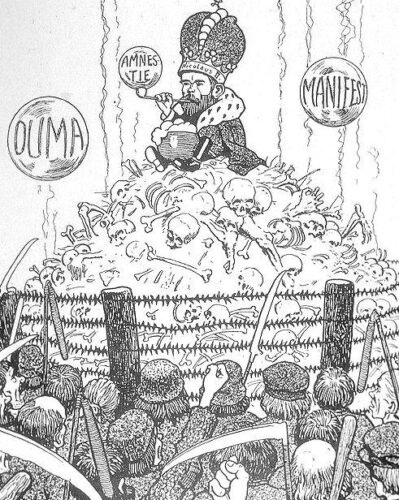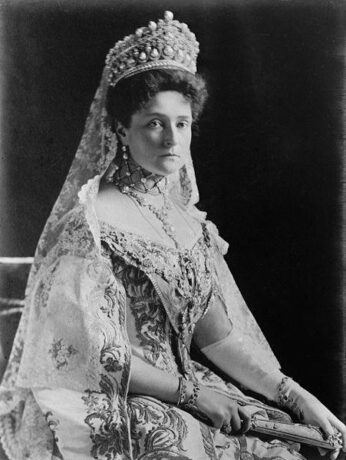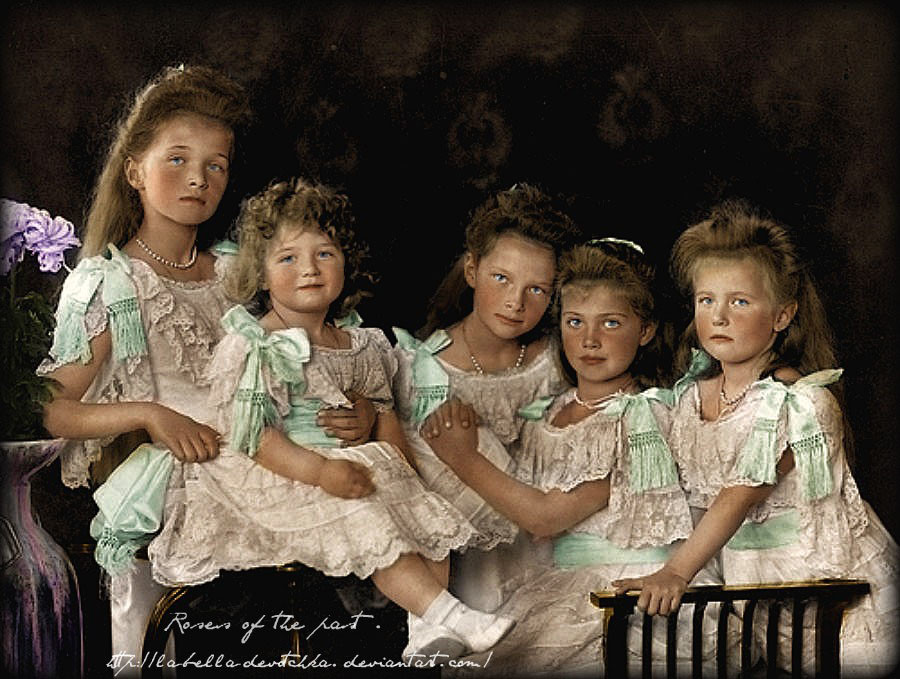
Nicholas II, the last tsar of Russia, had neither the qualities or the desire to rule Imperial Russia. Born in Tsarskoye Selo in 1868, Nicholas was the eldest son of Alexander III, the fearsome tsar who had reimposed autocracy and oppression on the Russian empire after the murder of Alexander II. The young Nicholas could not have been less like his father: he was short, shy and softly-spoken, by all accounts a good student of above average intelligence but hardly imposing or intimidating. Those who met the young Tsarevich described him as pleasant and likeable but otherwise unremarkable – hardly the traits of a man ordained by God to rule Russia. As a youth Nicholas had joined the imperial cavalry and attained the rank of colonel. Nicholas also had the opportunity to travel widely, at one stage suffering an assault by a Japanese national while visiting Asia, leaving him with bitter feelings towards Japan.
Raised in a sheltered world and kept at arm’s length from the Russian population, Nicholas held a twisted view that rebellion and revolutionary ideas were the products of dark forces. In most cases, he attributed them to fractious students or, more often, Russia’s five million Jews. Nicholas was at least partly responsible for the creation of the anti-Jewish hoax The Protocols of the Elders of Zion; he was willing to provide moral and financial support to reactionary and anti-Semitic groups like the Black Hundreds. Nicholas was also an imperialist who associated territorial expansion with success and glory. The ill-fated forays into Korea that triggered the Russo-Japanese wars were largely his doing, ordered against the advice of his ministers and generals.

Conventional historiography, steeped in liberal Western animosity towards communism, has tended to portray Nicholas as a pathetic figure: a victim rather than a failure. He was a politically weak and short-sighted ruler who was undermined by a domineering wife, a society in transition and a world war that fractured the pillars of tsarism. A more realistic study reveals a leader who was more responsible for his own fate than is often suggested. Nicholas was out of touch with his people but no more than other monarchs of his era. Very early in his reign, he resolved to follow his dead father in upholding and reinforcing the autocratic monarchy. Confronted with some glaring warning signs in 1905 – a humiliating military defeat, a frozen economy, political violence and an outraged people – Nicholas ignored them all, promising reform but doing so with no sincerity. When he signed the April 1906 Fundamental Laws, Nicholas might as well have signed his own death warrant.
“As tsarina, Alexandra cut an awkward figure. Her chief characteristics were her Victorian insistence on ‘good works’ and her religiosity. She had been schooled according to the strict, self-denying values of her grandmother [Queen Victoria]. Her attempt to introduce sewing circles among the ladies of the Russian high aristocracy underlined her eccentricity. Alexandra balanced her alien characteristics with a mania for the Russian Orthodox Church. She had the enthusiasm of the convert (in her case, from Protestantism). Her tendency to mysticism and spiritualism was not unusual for the time… St Petersburg was a magnet for religious cranks and faith healers, some of whom were taken in by high society.”
Jonathan Bromley, historian
Nicholas’ wife was Princess Alexandra of Hesse, like her husband a grandchild of Queen Victoria of England. The marriage between Nicholas and Alexandra was unusual for several reasons. Few wanted the pair to marry, including both Alexander III and Queen Victoria herself, who despaired when she learned that Alix (as Alexandra was known to those around her) had become engaged to the Russian crown prince. Victoria’s fears turned out to be justified. Unlike most royal marriages of the 19th century, the union between Nicholas and Alexandra was based on love rather than political convenience. They wrote sincere and passionate letters and addressed each other with a list of nicknames, including “Sunny”, “Lovey”, “Spitsbub” or “Pussy-Mine”. They preferred spending time away from the hubbub of St Petersburg, either at their palace in Tsarskoye Selo, 20 miles outside the capitol or their Crimean resort on the Black Sea coast.

The royal couple pined for a son to ensure the longevity of the Romanov dynasty. Their concerns were eased in 1904 when after four daughters – Olga, Maria, Tatiana and Anastasia – the tsarina gave birth to the royal couple’s only son Alexei. Within months, however, it was clear that the Tsarina had passed onto her son the defective gene that causes haemophilia. Several European royals endured this deadly burden. Haemophilia was carried by women but its symptoms only affected males. Haemophilia prevented blood from clotting naturally. It placed its sufferers at serious risk of a fatal haemorrhage, even the most insignificant cut, scratch or bruise. Very few haemophiliacs lived into their 30s; most died in childhood. Knowing she had given her son this fatal gift, even while suffering no ill effects from it herself, tortured Alexandra for the rest of her days.
The Tsarina is best remembered for helping to discredit the Romanov dynasty in its final war-ravaged months. Her husband’s timidity and trust in Alexandra meant that he was susceptible to her suggestions and her nagging. Alexandra herself was politically strong-minded but largely ill-informed, the kind of partner that such a weak ruler didn’t need. A convert to the Russian Orthodox faith, she was devout in her worship and a firm believer in her husband’s divine right to rule. Alexandra’s letters and nattering reinforced Nicholas’ belief in the old ways, talked him out of reforms or concessions, and turned him against the few men who might offer him sensible advice. She also filled the tsar with confidence and assurance in his personal leadership which Nicholas simply didn’t have.

1. Nicholas II, the last Tsar of Russia and the son of Alexander III, took the throne swearing to preserve the autocracy.
2. He was intelligent and well-travelled but lacked both the demeanour and foresight to rule at a time of unfolding change.
3. He was also religious, conservative and thought problems in his regime were the work of conspirators.
4. Nicholas’ wife Alexandra was a German-speaking princess. They married against the wishes and advice of others.
5. Alexandra was devoutly religious and strong-willed: her association with Rasputin and her political advice and influence on Nicholas during times of crisis contributed to the downfall of tsarism.
© Alpha History 2018. Content on this page may not be republished or distributed without permission. For more information please refer to our Terms of Use.
This page was written by Jennifer Llewellyn, John Rae and Steve Thompson. To reference this page, use the following citation:
J. Llewellyn et al, “Tsar Nicholas II” at Alpha History, https://alphahistory.com/russianrevolution/tsar-nicholas-ii/, 2018, accessed [date of last access].

